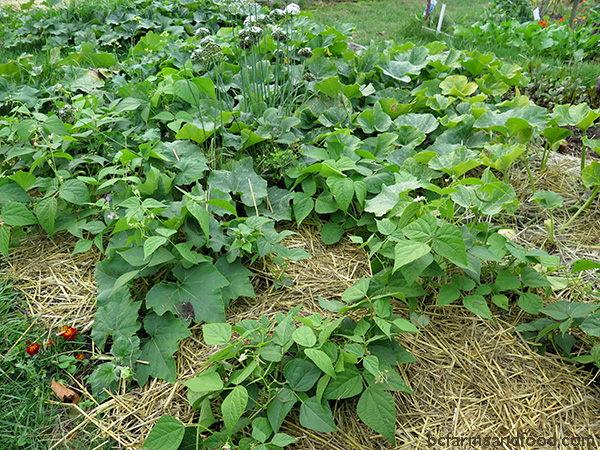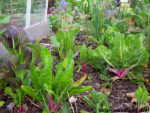Protect your Plants from Heat, Cold, Wind and Rain
Creating Microclimates to Make Your Garden Resilient
Wondering how to grow a healthy garden in the face of weather extremes? Protect your plants using microclimates. Here are 13 easy ways to protect plants from wind, rain, cold, heat, and drought.

Cold frames protect vegetables from cold, wind, rain and frost, and extend the growing season.
Using Microclimates to Shelter Plants from Weather Extremes
Adapting your growing area to protect young plants from wind, rain, cold, heat, and drought is key to a successful garden. You can do this by creating microclimates—specially designed areas in your garden that offer protection from the elements, so that your plants can thrive.
Microclimates are small areas that have different growing conditions from the surrounding region. These spaces can shelter plants and seedlings that are not strong enough to survive weather extremes. For example, a microclimate such as a wind buffer or a sun trap (a space that captures heat and sunlight) can shelter plants from cold. In drought conditions, a cool microclimate, such as the area under a tree canopy or an umbrella, can shade the plants beneath it and retain water to minimize heat stress.
As climate change brings more weather extremes, it is more important than ever to build microclimates into your garden. The predictable weather patterns we knew and counted on are becoming unpredictable. One week the weather may be hot and sunny—perfect for tomato transplants. The next week a cold wind pushes over young plants and chills their roots. When you create microclimate shelter areas in your garden, you help plants not only survive, but flourish during unpredictable weather.

Tall plants and a pail provide a shaded, wind-protected microclimate for these tiny lettuce seedlings.
How to Protect Plants from the Wind
Wind dries out seedlings and young plants. It chills the roots and stems, and can blow over growing vegetables. Making a wind buffer can provide the shelter your plants need to survive.
• Situate vulnerable plants near a wind barrier. Tall vegetables or vine-covered trellises offer shelter from the wind to nearby plants. Buildings, fences, trees and shrubs also alter wind patterns, creating protected zones. Please note, however, these barriers create a cold zone on the side facing the wind.
• Set up pails, straw bales, glass window panes, or garden furniture strategically to obstruct wind. This will warm roots and protect tender stems of new transplants.

A free-standing plastic overhang protects these dry-weather fruit trees from rain.
How to Protect Plants from the Rain
Heavy rains and standing water leave plants overly wet. Too much rain washes away seeds, damages seedlings, chills plants and compacts the soil.
• Take advantage of tree cover. Large trees offer protection from the rain to plants growing under their canopies. Tree roots, however, sometimes compete for available nutrients and water, making it hard to grow smaller plants near the base of the tree.
• Use building overhangs to create a rain shadow. Overhangs prevent precipitation from reaching the ground and keep plants dry. Hand-built supports covered with heavy plastic or glass panes can provide rain protection while still allowing ample light.
• Set up portable buffers for rain, wind and cold. These include cloches, upside-down plastic milk jugs, jars, or pots over seedlings. Plastic- or burlap-wrapped tomato cages will also shelter transplants.

A raised bed with rock walls provides a warm microclimate for heat-loving zucchini plants. The rocks absorb heat by day and release it at night.
How to Protect Plants from the Cold
Cold has a lot to do with location. A northern exposure lacks sun and will be colder and often shadier than other orientations. The top of a hill is coldest and windiest. Cold air and water flow down and can pool at the base of a hill. Midway down a slope conditions are more moderate.
• Plant in raised beds or terraces, oriented to the south. This can mitigate cold by warming and draining the soil quickly. Raised beds warm up earlier in the spring than the surrounding lower ground.
• Take advantage of radiant heat. Rocks, bricks, pavement and gravel produce radiant heat. During the day, they absorb heat from the sun, which they release at night. Terraces edged with rocks will hold thermal mass and warm nearby plants. Reflected water of ponds, pools, and streams can also provide warmth to adjacent plantings.
• Use a sun trap to take advantage of sun exposure and radiant heat. Planting against a south or west wall or fence creates a sun trap that captures warmth for heat-loving plants like tomatoes and peppers. Sun exposure is warmest when facing south. A western exposure is also warm.
• Surround your plants with dark-coloured mulch. A dark mulch, such as black plastic, will heat the soil and encourage early plant growth.
• Grow your plants under cover. In cool seasons, greenhouses, hoop houses, row covers, and cold frames can extend the growing season and protect plants from cold, frost, wind, and rain.

Mulch such as straw, leaves or grass clippings helps keep the soil cool and moist during hot, dry conditions. Mulch can be a good insulator in any weather.
Protecting Plants from Heat and Sun
Too much heat and sun exposure can dry out plants. Excessive heat causes leaf wilt as plants transpire moisture to protect themselves from high temperatures and sun. At temperatures over 30º C (about 90º F), tomatoes and peppers often become sunburned and stop flowering.
• Provide shade for garden plants when it is hot. To alleviate heat, cast a shadow over plants with an umbrella, shade cloth, or any light fabric stretched out along a support. Tall flowers or trellises can also provide shade for seedlings and vulnerable transplants.
• Mulch around vegetable plantings with straw, leaves or dried grass clippings to cool and keep the soil moist. In very hot conditions, use a thick mulch 10–15 cm (4–6 inches) deep to provide protection.
• Water consistently to create a stable environment for plant growth. During hot periods, water in the morning or early evening so moisture can reach the plant roots without evaporating. Deep watering 2-3 times per week keeps the soil more evenly moist than superficial watering.
More about gardening:
 Grow a Climate Change Resilient Garden
Grow a Climate Change Resilient Garden
 10 Tips for Year-Round Vegetable Gardens
10 Tips for Year-Round Vegetable Gardens
 Growing a Patio Lemon Tree in Winter
Growing a Patio Lemon Tree in Winter










